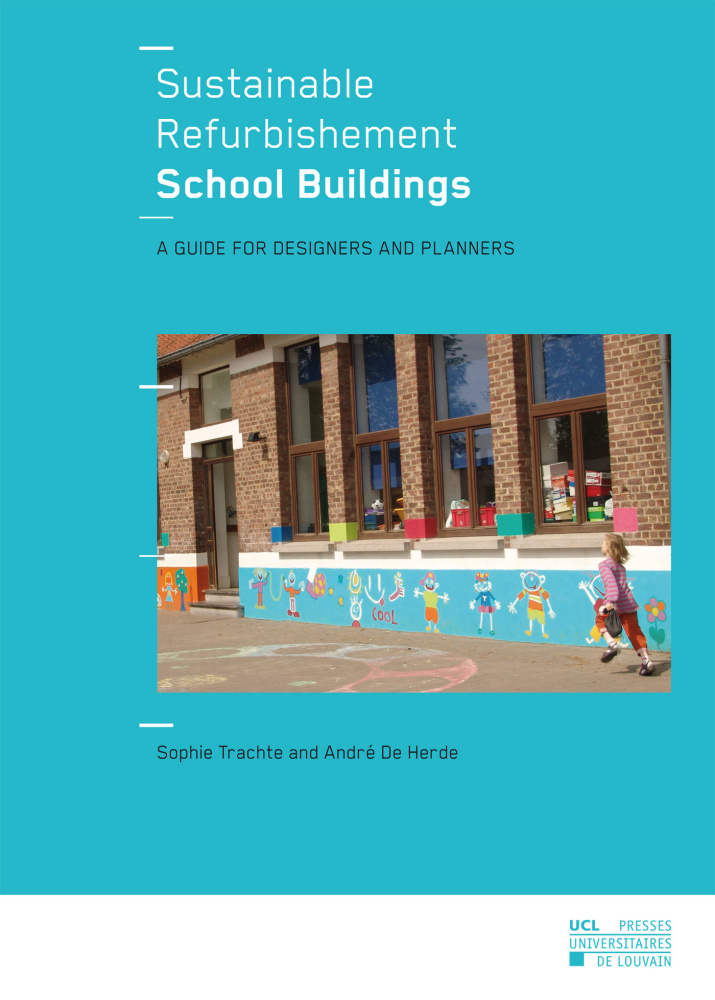Sustainable Refurbishement School Buildings
A guide for designers and planners
Première édition
At a time when major climate change and aspiration for sustainable economic and social development have become major issues, the objective of this guide is to consider school retrofitting from a holistic point of view by developing guidelines not just in terms of energy performances or solar systems but also in terms of comfort, quality of life, environmental impact and resource consumption.
Across Europe and worldwide, infant, primary and secondary schools are essential tools in the construction of tomorrow's society and transmission of democratic values.
Schools are, first and foremost, places for opening up to the world, to the acquisition of knowledge and places for socialisation: three indispensable foundations for becoming a citizen of tomorrow's world, capable of good governance.
This is a fundamental role in our societies. In order to fulfill this role, schools must provide places for training and teaching that are comfortable and of high quality. This is currently not the situation in Europe. Most school buildings are old, dilapidated and poorly insulated. Heating systems too are old and often cannot be regulated. Ventilation systems, if any, are inefficient. Outdoor spaces and playgrounds are often restricted and of poor quality.
This lack of comfort has negative and scientifically proven consequences on pupils’ concentration and learning. This is why school buildings have an urgent need of fundamental refurbishment.
Moreover, sustainable and cost-efficient refurbishment of school buildings provides a real opportunity for making pupils, teachers and parents aware of energy efficiency as well as comfort and the quality of indoor and outdoor environments. School buildings, their technical equipment and operation can be used as a showcase for the pupils and their families. A showcase that, once experienced, can influence their attitudes and lead them to behave in a more responsible and public-spirited way.
This guide is mainly intended for architects and architecture students and also for principals and other school administrative authorities.
Richly illustrated with both explanatory diagrams and photographs, the guide provides designers with information and resources needed to retrofit school buildings in a responsible and efficient way.
Spécifications
- Éditeur
- Presses universitaires de Louvain
- Édité par
- Sophie Trachte, André De Herde,
- Langue
- anglais
- BISAC Subject Heading
- ARC000000 ARCHITECTURE > ARC018000 ARCHITECTURE / Sustainability & Green Design
- Code publique Onix
- 06 Professionnel et académique
- CLIL (Version 2013-2019 )
- 3076 Architecture/Urbanisme
- Date de première publication du titre
- 19 octobre 2015
Livre broché
- Date de publication
- 19 octobre 2015
- ISBN-13
- 978-2-87558-338-3
- Ampleur
- Nombre de pages de contenu principal : 334
- Code interne
- 90606
- Format
- 27,9 x 21 cm
- Poids
- 803 grammes
- Prix
- 80,00 €
- ONIX XML
- Version 2.1, Version 3
- Date de publication
- 15 octobre 2015
- ISBN-13
- 978-2-87558-339-0
- Code interne
- 90606PDF
- ONIX XML
- Version 2.1, Version 3
Google Livres Aperçu
Publier un commentaire sur cet ouvrage
Sommaire
Contributors
Foreword
0. Introduction 015
0.1. School refurbishment: a challenge, locally and for Europe 017
0.2. School buildings: buildings with special characteristics 017
0.3. Refurbishment of school buildings, two major priorities 020
0.4. Sustainable refurbishment of schools: definition and priorities 021
0.5. Energy regulation and environmental certifications 028
0.6. Conducting a successful school refurbishment project 038
1. Comfort and Quality of life 043
1.1. Concept of comfort 047
1.2. Optimising classrooms comfort - goals to be achieved 053
1.3. Ensuring the thermal comfort of children and teachers in the school 058
1.4. Optimising visual comfort in school building 103
1.5. Optimising acoustic comfort 112
1.6. Ensuring good indoor air quality 124
1.7. School, a place for teaching and learning 138
1.8. Improving the quality-of-life in school 148
1.9. Comfort and quality of life - Breeam assessment method 160
2. Services and energy efficiency 167
2.1. Preamble 171
2.2. Optimising the existing heating system 171
2.3. Optimising the production of sanitary hot water 186
2.4. Heating generation by heat pump in school renovation 188
2.5. Using solar energy for production of sanitary hot water 197
2.6. Optimising the artificial lighting in classrooms 198
2.7. Electricity production through cogeneration systems 215
2.8. Electricity production from renewable sources 217
2.9. Heat recovery from a ventilation system 231
2.10. Preheating / precooling of air by underground heat exchanger 236
2.11. Services and energy efficiency - Breeam assessment method 237
Picture: Sylvie Rouche
3. Reduce resources consumption 241
3.1. Reducing drinking water consumption 245
3.2. Replenishing water resources and reducing rainwater runoff 259
3.3. Controlling consumption of natural resources 267
3.4. Reduce resources consumption - Breeam assessment method 287
4. Reduce waste production 293
4.1. Recycling waste water 295
4.2. Reducing, managing and using construction and demolition waste 311
4.3. Reducing, managing and added value from functional waste 323
4.4. Reduce waste production - Breeam assessment method 326
References 329

